Pinpointing Policy: Are you ready for more base acres?
Published
9/5/2025
The One Big Beautiful Bill Act (OBBBA), signed into law on July 4, 2025, makes provisions to expand base acres by up to 30 million to better align them with recent planting history. This is great news for Kansas farmers as preliminary analyses by both the University of Illinois and the University of Missouri suggest Kansas could be in line for an increase of nearly 2 million acres on top of the 20.97 million acres of base currently eligible for participation in the Agricultural Risk Coverage (ARC) and the Price Loss Coverage (PLC) programs.
Why are base acres important? Because Title 1 farm programs such as ARC and PLC make payments on historical planted acreage, i.e., “base acres,” not actual plantings, for that particular year. This decoupling serves two purposes:
- It gives farmers the flexibility to “plant for the market,” and adapt to market conditions without jeopardizing their eligibility for price or revenue support; and
- It makes U.S. Title 1 payments less distorting to global trade, i.e., more World Trade Organization (WTO) friendly, because they have nothing to do with current agricultural production and planting decisions.
According to the Economic Research Service (USDA-ERS), “Acreage bases were originally determined in the early 1980s and continued through the mid-1990s as part of the annual acreage reduction and deficiency payment programs.” But, while base acres have been a part of farm programs for decades, they’ve been mostly frozen since 1996, with the 2002 farm bill offering the last opportunity to update/add base acres as part of including soybeans as a program crop.
The 2014 farm bill removed cotton as a program crop to resolve a WTO case, cotton base acres were then converted to generic base acres, and farmers were provided a voluntary one-time reallocation of existing base acres to reflect covered commodities planted on the farm during the 2008 to 2012 crop years. With the Bipartisan Budget Act of 2018, cotton was reinstated as a program crop, and farms with a history of planting cotton between 2009 and 2016 received an allowance for seed cotton base acres.
But there is a problem.
For many Kansas farms, there are cropped acres that have no base. Possibly because the previous landowner never participated in farm programs or the land had been in alfalfa or some other non-base earning crop when the “base” was established. These farms with disproportionately low base acres relative to their actual cropped acreage are less protected by the farm safety net provided through Title 1 Commodity Programs.
American Farm Bureau Federation (AFBF) policy is supportive of this effort, as #239 / National Farm Policy states under we support, 9.1.40. Base acres and yields being adjusted yearly, on a voluntary basis, using a five-year average.
The idea of increasing base acres and getting more specific language into AFBF policy was discussed by the KFB Wheat Advisory committee for a couple years. In 2023, the committee forwarded a new line in AFBF #239 / National Farm Policy under we support, “Farmers having the ability to establish base acres on added farmland that does not have base.” The language passed at the KFB annual meeting that December, was forwarded to the AFBF Resolutions Committee, but was not included in the AFBF Report to delegates the following January. In 2024, similar language was forwarded by the committee, added to line 9.1.40, under we support, Base acres and yields being adjusted yearly, on a voluntary basis, using a five-year average, and the ability to establish base acres on cropland that has changed owner, operator, or practice that does not have base acres. But this language too, ultimately did not make it into our AFBF policy.
So where are we now?
Currently, details are a bit sketchy, with many questions needing to be answered as this is rolled out in 2026 (for the 2026 program year with payments arriving in 2027), but it’s not too soon to be researching, learning and preparing for the decisions you’ll need to make.
From the University of Missouri, “According to the OBBBA, a farm is eligible to receive an allocation of new base acres if the updated base acres exceed the total number of base acres for covered commodities in the farm on Sept. 30, 2024 (current base acres).
- updated base acres = the 2019-2023 average of acres planted, failed and prevented from being planted to covered program commodities on the FSA farm plus the lesser of,
- 15 percent of total acres on the FSA farm, or
- 2019-2023 average of acres planted, failed and prevented from being planted to eligible noncovered commodities on the FSA farm.
While much of this data is readily available, for example, planted, failed and prevented planted acres are normally recorded on your FSA-578 acreage report each year, and as part of the rollout, your local FSA office might calculate this for you. The only thing you may need to do is carefully check it for accuracy.
A big question is, how will total acres on the FSA farm be defined? Is it restricted to planted acres or tillable (i.e. potential planted) acres? Will it include land in CRP? Will it include trees, bushes, vines, fallow and/or idle acres? How will tame pasture (brome, fescue, etc.) be handled, originally it was planted but now is only harvested each year? What about hay meadows and native range, will it be included in total acres on a farm?
A few other questions:
- Will acres be added to farms with no current base acres?
- Will it be applied evenly (assuming there are more than 30 million acres available) to all farms (pro rata), or will some farms (i.e. young farmers or smaller farms) be prioritized?
- Will it only be available to farms that “apply” for an expansion of base? And if so, will there be any advantage to getting an application early?
- If I have more potential acres to add to my base than will be allowed, will I be able to choose which program crops are added, for example add corn base instead of wheat?
While every FSA farm will be different and every farmer will have different choices to make, this opportunity to update base acreage could be more impactful for some farms than the upcoming increases in reference prices. Additionally, this increase in base acres, coupled with the increases in reference prices may well be the last time we significantly improve our Title 1 Commodity Programs.
Below are maps depicting current base acres in Kansas in total, and for wheat, corn, soybeans and grain sorghum. Together, those four crops represent 99 percent of all base acres for Kansas, with the base acreages of barley, canola, dry peas, flaxseed, mustard seed, oats, safflower, seed cotton, sesame seed and sunflower seed combining for another 1 percent of the total.
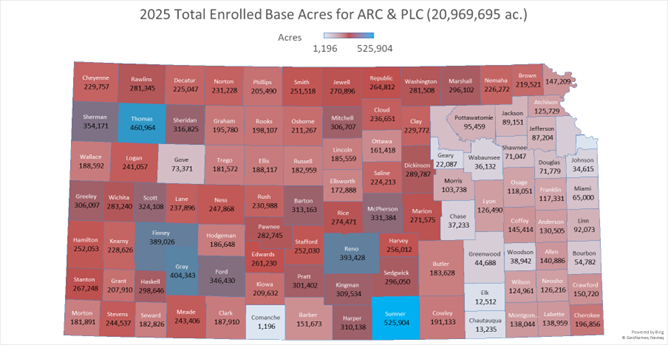
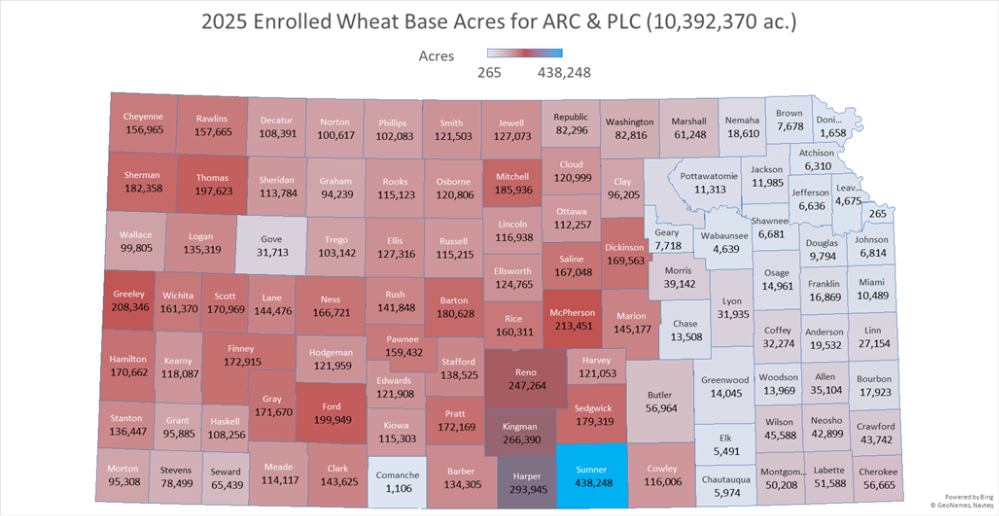
Note: the 2019/23 average of wheat planted in Kansas is 7,280,000 acres according to USDA-NASS.
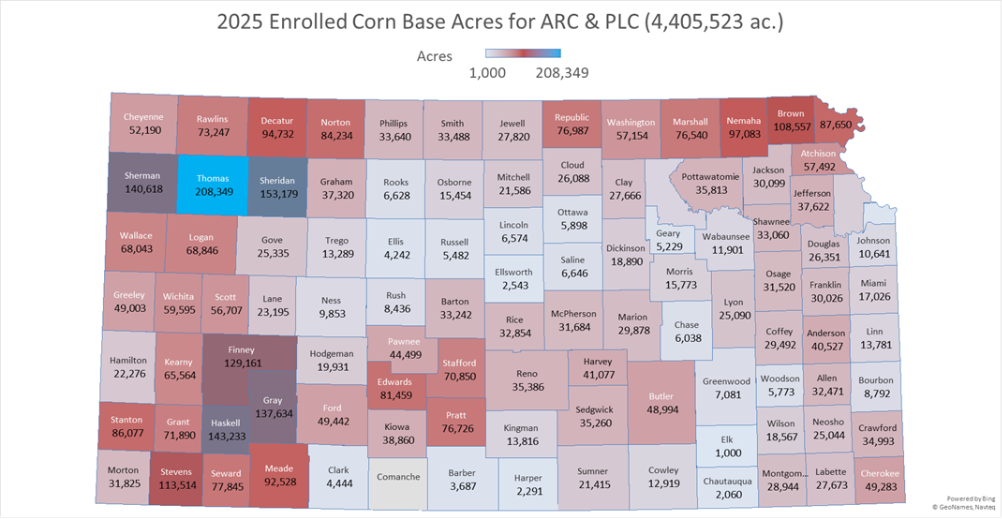
Note: the 2019/23 average of corn planted in Kansas is 5,890,000 acres according to USDA-NASS.
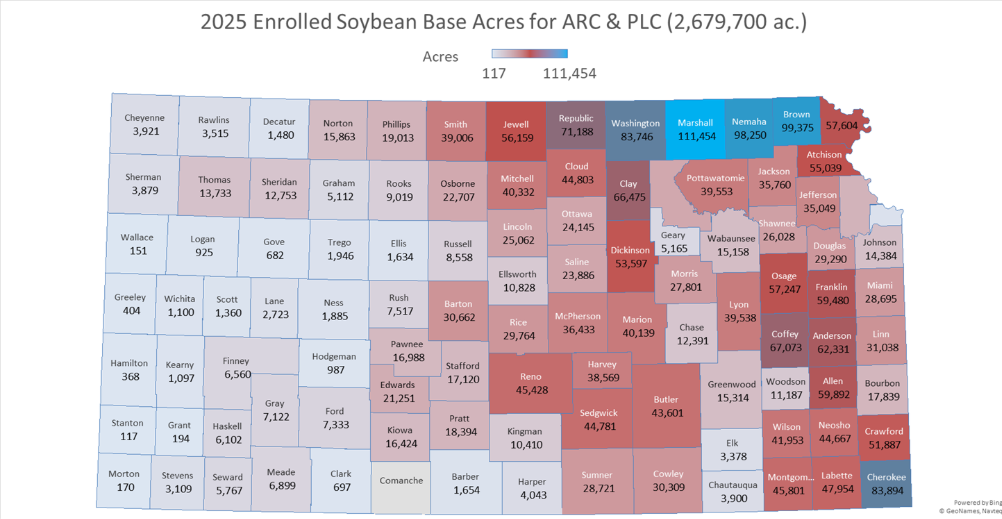
Note: the 2019/23 average of soybeans planted in Kansas is 4,736,000 acres according to USDA-NASS.
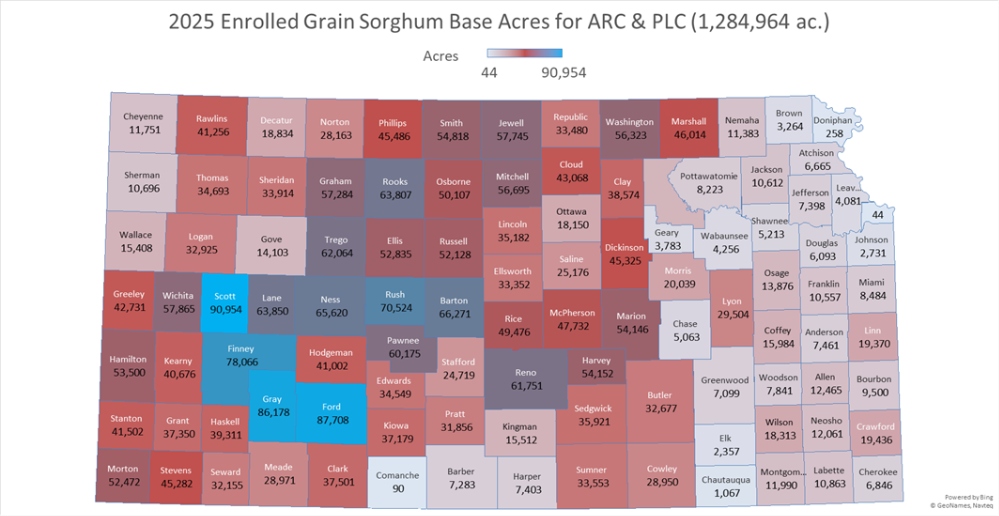
Note: the 2019/23 average of grain sorghum planted in Kansas is 3,220,000 acres according to USDA-NASS.